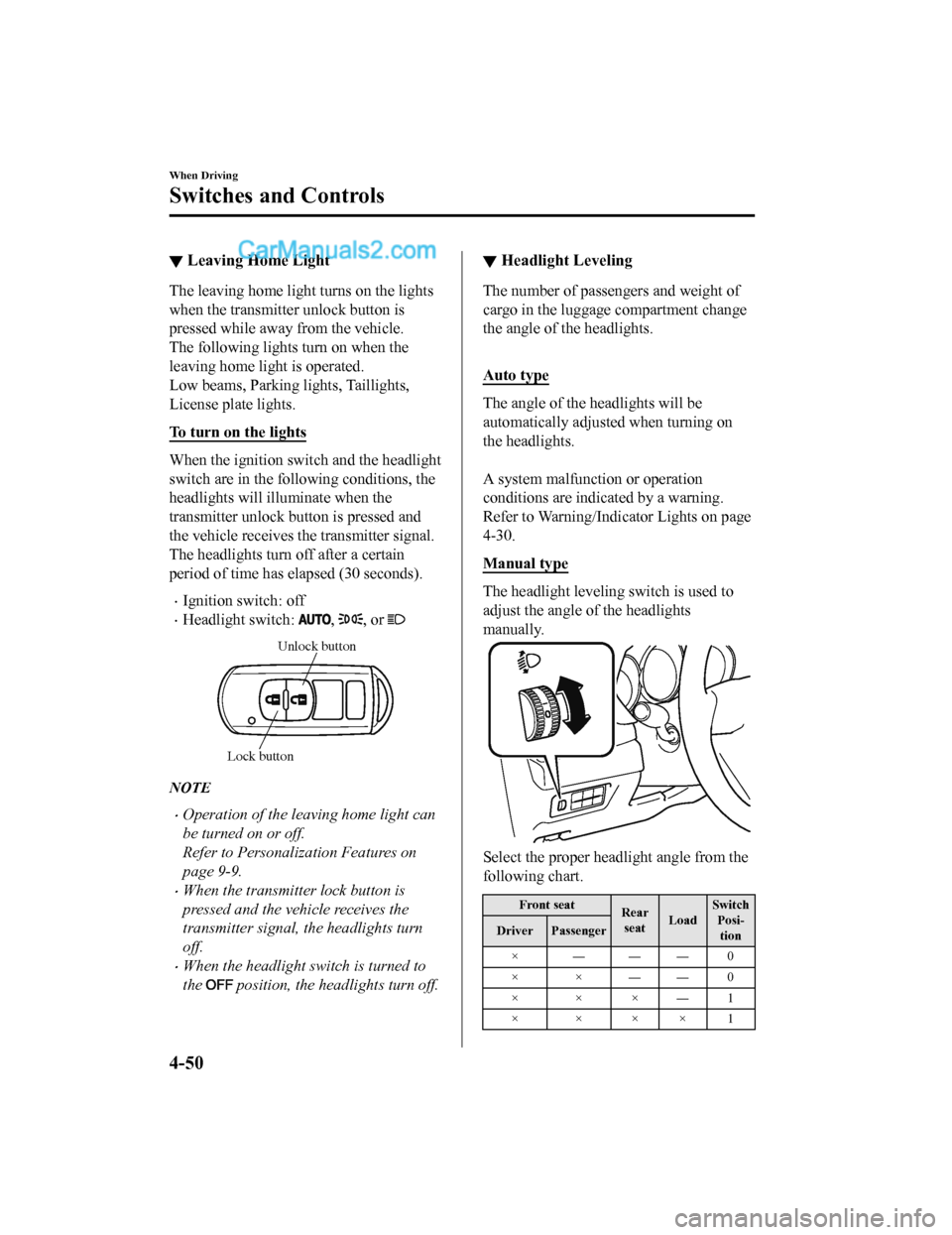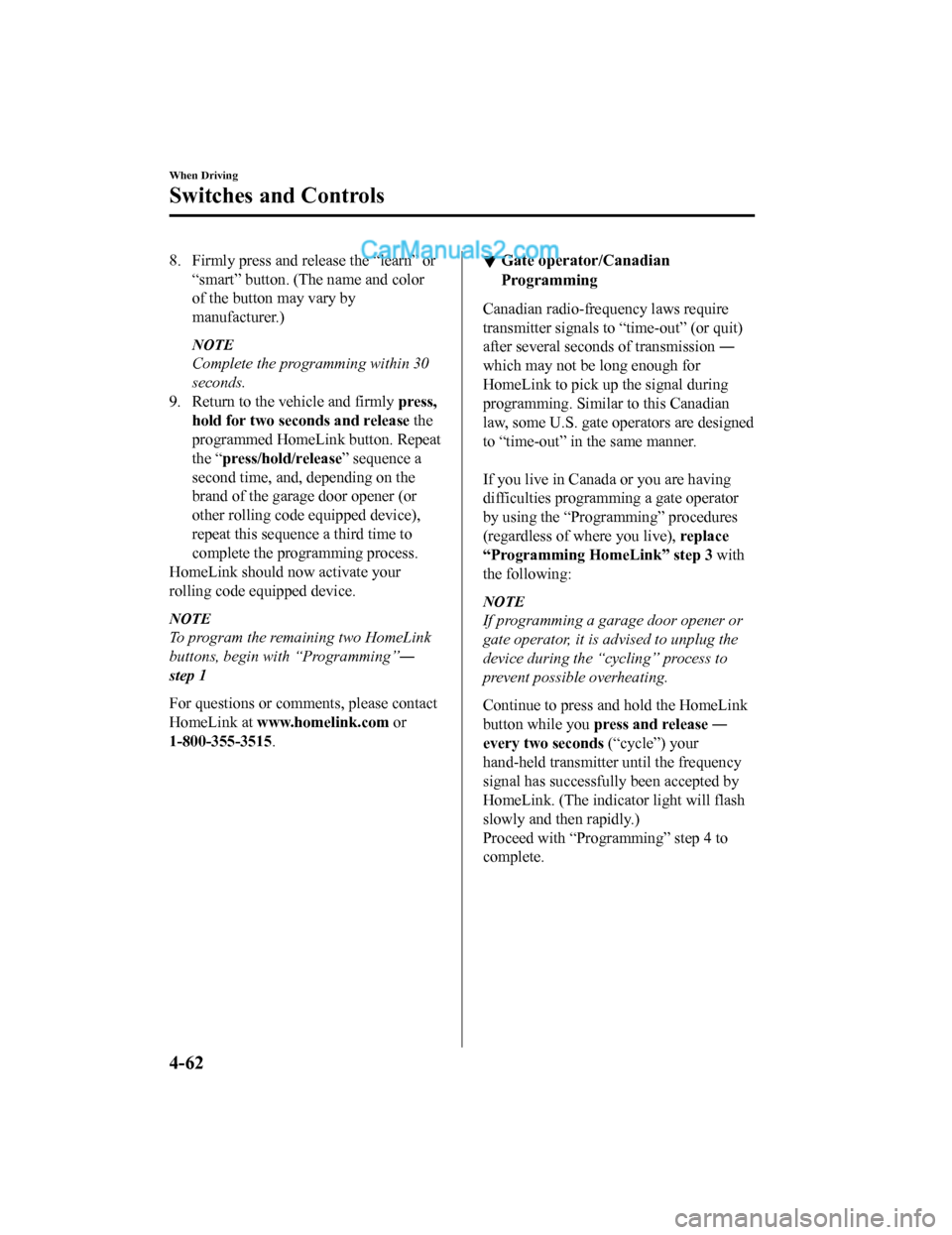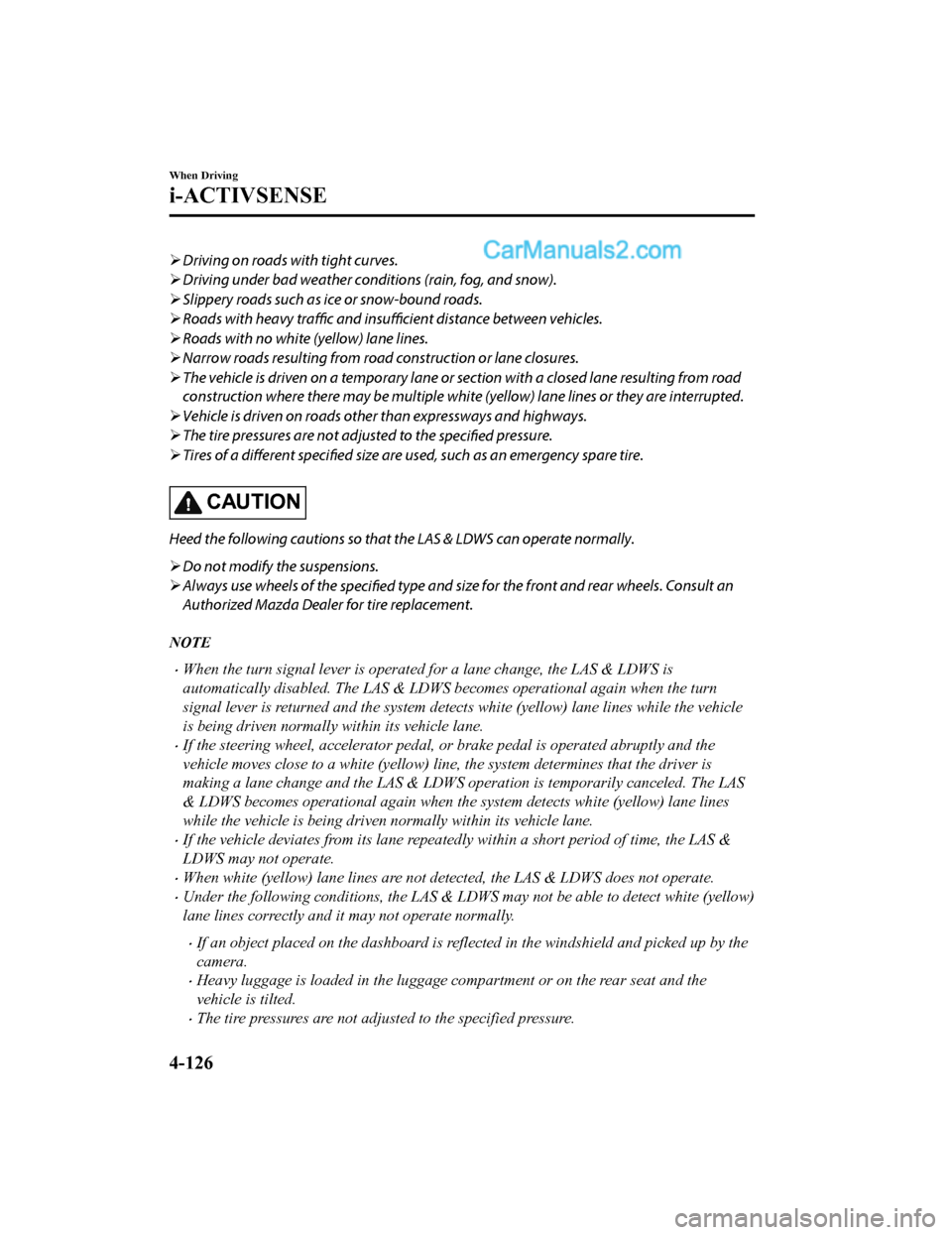turn signal MAZDA MODEL CX-5 2018 (in English) User Guide
[x] Cancel search | Manufacturer: MAZDA, Model Year: 2018, Model line: MODEL CX-5, Model: MAZDA MODEL CX-5 2018Pages: 628, PDF Size: 82.38 MB
Page 176 of 628

Manual Shift Mode
The manual shift mode gives you the feel
of driving a manual transaxle vehicle by
allowing you to operate the selector lever
manually. This allows you to control
engine rpm and torque to the drive wheels
much like a manual transaxle when more
control is desired.
To change to manual shift mode, shift the
lever from D to M.
NOTE
Changing to manual shift mode while
driving will not damage the transaxle.
To return to automatic shift mode, shift the
lever from M to D.
NOTE
•If you change to manual shift mode
when the vehicle is stopped, the gear
will shift to M1.
•If you change to manual shift mode
without depressing the accelerator pedal
when driving in D range, 5th gear/6th
gear, the gear will shift to M4/M5.
▼ Indications
Manual shift mode indication
In manual shift mode, the “M” of the shift
position indication in
the instrument panel
illuminates.
Gear position indication
The numeral for th e selected gear
illuminates.
Manual shift mode
indicationGear position indication
NOTE
•If the gears cannot be shifted down
when driving at higher speeds, the gear
position indication will flash twice to
signal that the gears cannot be shifted
down (to protect the transaxle).
•If the automatic tr ansaxle fluid (ATF)
temperature becomes too high, there is
the possibility that the transaxle will
switch to automatic shift mode,
canceling manual shift mode and
turning off the gear position indication
illumination. This is a normal function
to protect the AT. After the ATF
temperature has decreased, the gear
position indication illumination turns
back on and driving in manual shift
mode is restored.
When Driving
Automatic Transaxle
4-40
CX-5_8GN5-EA-17J_Edition1 2017-8-18 12:58:27
Page 186 of 628

▼Leaving Home Light
The leaving home light turns on the lights
when the transmitte
r unlock button is
pressed while away from the vehicle.
The following light s turn on when the
leaving home light is operated.
Low beams, Parking lights, Taillights,
License plate lights.
To turn on the lights
When the ignition switch and the headlight
switch are in the following conditions, the
headlights will il luminate when the
transmitter unlock button is pressed and
the vehicle receives the transmitter signal.
The headlights turn off after a certain
period of time has elapsed (30 seconds).
•Ignition switch: off
•Headlight switch: , , or
Unlock button
Lock button
NOTE
•Operation of the leaving home light can
be turned on or off.
Refer to Personalization Features on
page 9-9.
•When the transmitter lock button is
pressed and the vehicle receives the
transmitter signal, the headlights turn
off.
•When the headlight switch is turned to
the
position, the headlights turn off.
▼ Headlight Leveling
The number of passengers and weight of
cargo in the luggage compartment change
the angle of the headlights.
Auto type
The angle of the headlights will be
automatically adjusted when turning on
the headlights.
A system malfunction or operation
conditions are indicated by a warning.
Refer to Warning/Indicator Lights on page
4-30.
Manual type
The headlight leveling switch is used to
adjust the angle o
f the headlights
manually.
Select the proper headlight angle from the
following chart.
Front seat Rear
seat LoadSwitch
Posi-tion
Driver Passenger
×―――0
××――0
×××―1
××××1
When Driving
Switches and Controls
4-50
CX-5_8GN5-EA-17J_Edition1 2017-8-18 12:58:27
Page 188 of 628

Turn and Lane-ChangeSignals
The ignition must be switched ON to use
the turn and lane -change signals.
▼Turn Signals
Move the signal lever down (for a left
turn) or up (for a righ
t turn) to the stop
position. The signal will self-cancel after
the turn is completed.
If the indicator light continues to flash
after a turn, manually return the lever to its
original position.
Right turn
Left turn
Right lane change
Left lane change OFF
The turn signal
indicators in the
instrument cluster flash according to the
operation of the turn signal lever to show
which signal is working.
NOTE
•If an indicator light stays on without
flashing or if it flashes abnormally, one
of the turn signal bulbs may be burned
out.
•A personalized function is available to
change the turn indicator sound volume.
(page 9-9)
▼ Lane-Change Signals
Move the lever halfway toward the
direction of the lane change―until the
indicator flashes― and hold it there. It
will return to the off position when
released.
▼Three-Flash Turn Signal
After releasing the turn signal lever, the
turn signal indicator flashes three times.
The operation can be cancelled by moving
the lever in the direct
ion opposite to which
it was operated.
NOTE
The three-flash turn signal function can be
switched to operable/inoperable using the
personalization function.
Refer to Personalization Features on page
9-9.
When Driving
Switches and Controls
4-52
CX-5_8GN5-EA-17J_Edition1 2017-8-18 12:58:27
Page 195 of 628

Horn
To sound the horn, press the mark on
the steering wheel.
Hazard Warning Flasher
The hazard warning lights should always
be used when you stop on or near a
roadway in an emergency.
The hazard warning lights warn other
drivers that your vehicle is a traffic hazard
and that they must take extreme caution
when near it.
Depress the hazard warning flasher and all
the turn signals will flash. The hazard
warning indicator lights in the instrument
cluster flash simultaneously.
NOTE
•The turn signals do not work when the
hazard warning lights are on.
•Check local regulations about the use of
hazard warning lights while the vehicle
is being towed to verify that it is not in
violation of the law.
When Driving
Switches and Controls
4-59
CX-5_8GN5-EA-17J_Edition1 2017-8-18 12:58:27
Page 198 of 628

8. Firmly press and release the “learn” or“smart” button. (The name and color
of the button may vary by
manufacturer.)
NOTE
Complete the progr amming within 30
seconds.
9. Return to the vehicle and firmly press,
hold for two seconds and release the
programmed HomeLink button. Repeat
the “ press/hold/release” sequence a
second time, and, depending on the
brand of the garage door opener (or
other rolling code equipped device),
repeat this sequence a third time to
complete the programming process.
HomeLink should now activate your
rolling code equipped device.
NOTE
To program the remaining two HomeLink
buttons, begin with “Programming” ―
step 1
For questions or comments, please contact
HomeLink at www.homelink.com or
1-800-355-3515 .
▼Gate operator/Canadian
Programming
Canadian radio-frequency laws require
transmitter signals to
“time-out” (or quit)
after several seconds of transmission ―
which may not be long enough for
HomeLink to pick up the signal during
programming. Similar to this Canadian
law, some U.S. gate operators are designed
to “time-out” in the same manner.
If you live in Canada or you are having
difficulties programming a gate operator
by using the “Programming” procedures
(regardless of where you live), replace
“Programming HomeLink” step 3 with
the following:
NOTE
If programming a garage door opener or
gate operator, it is advised to unplug the
device during the “cycling” process to
prevent possible overheating.
Continue to press and hold the HomeLink
button while you press and release ―
every two seconds (“cycle”) your
hand-held transmitter until the frequency
signal has successfully been accepted by
HomeLink. (The indicat or light will flash
slowly and then rapidly.)
Proceed with “Programming” step 4 to
complete.
When Driving
Switches and Controls
4-62
CX-5_8GN5-EA-17J_Edition1 2017-8-18 12:58:27
Page 227 of 628

NOTE
The timing in which the system switches the headlights changes under the following
conditions. If the system does not switch the headlights appropriately, manually switch
between high and low beams according to the visibility as well as road and traffic
conditions.
•When there are sources of light in the area such as street lamps, illuminated signboards,
and traffic signals.
•When there are reflective objects in the surrounding area such as reflective plates and
signs.
•When visibility is reduced under rain, snow and foggy conditions.
•When driving on roads with sharp turn or hilly terrain.
•When the headlights/rear lamps of vehicles in front of you or in the opposite lane are dim
or not illuminated.
•When there is sufficient darkness such as at dawn or dusk.
•When the luggage compartment is loaded with heavy objects or the rear passenger seats
are occupied.
•When visibility is reduced due to a vehicle in front of you spraying water from its tires
onto your windshield.
▼ To Operate the System
The HBC operates to s
witch the headlights
automatically between high and low
beams after the igni tion is switched ON
and the headlight sw itch is in the AUTO
and high beam position.
The HBC determines that it is dark based
on the brightness of the surrounding area.
At the same time, the HBC indicator light
(green) in the instrument cluster
illuminates.
The HBC determines that it is dark based
on the brightness of the surrounding area.
NOTE
•When the vehicle speed is about 30 km/h
(19 mph) or more, the headlights
automatically switch to high beams
when there are no vehicles ahead or
approaching in the opposite direction.
When the vehicle speed is less than
about 20 km/h (12 mph), the HBC
switches the headlights to low beams.
•The low beams may not switch to high
beams when cornering.
•Operation of the HBC function can be
disabled. Refer to Personalization
Features on page 9-9.
When Driving
i-ACTIVSENSE
4-91
CX-5_8GN5-EA-17J_Edition1 2017-8-18 12:58:27
Page 229 of 628

Blind Spot Monitoring (BSM)*
The BSM is designed to assist the driver in checking the area to the rear of the vehicle on
both sides during lane changes by notifying the driver of the p resence of vehicles
approaching from the rear in an adjacent lane.
The BSM detects vehicles approaching from the rear while travel ing in the forward
direction at a speed of 10 km/h (6.3 mph) or faster and notifie s the driver by turning on the
BSM warning indicator light and displaying the vehicle detectio n screen (vehicles with
multi-information display and active driving display).
If the turn signal lever is operated to signal a turn in the direction in which the BSM
warning indicator light is illumi nated while the approaching vehicle is detected, the BSM
notifies the driver of possible danger by turning on the BSM wa rning indicator light, and by
activating the warning sound and the warning screen indicator display (vehicles with
multi-information display and active driving display).
The detection area on this system covers the driving lanes on b oth sides of the vehicle and
from the rear part of the front d oors to about 50 m (164 ft) behind the vehicle.
Detection areas
Your vehicle
WA R N I N G
Always check the surrounding area visually before making an actual lane change:
The system is only designed to assist you in checking for vehicles at your rear when making a
lane change. Due to certain limitations with
the operation of this system, the BSM warning
indicator light, the warning sound and the warning screen indicator display may not activate
or they might be delayed even though a vehicle is in an adjacent driving lane. Always make it
your responsibility as a driver to check the rear.
When Driving
i-ACTIVSENSE
*Some models.4-93
CX-5_8GN5-EA-17J_Edition1 2017-8-18 12:58:27
Page 232 of 628

▼Blind Spot Monitoring (BSM) Warni
ng Indicator Light/Display Indicator/Blind
Spot Monitoring (BSM) Warning Beep
The BSM or Rear Cross Traffic Al ert (RCTA) system notifies the driver of the presence of
vehicles in adjacent lanes or at the rear of the vehicle using the BSM warning indicator
light, the warning sound and the display indicator (vehicles wi th multi-information display
and active driving display) (BSM) while the systems are operati onal.
BSM warning in dicator lights
The BSM warning indicator lights are equipped on the left and r ight door mirrors. The
warning indicator lights turn on when a vehicle approaching from the rear in an adjacent
lane is detected.
When the ignition is switched ON, the warning indicator light t urns on momentarily and
then turns off after a few seconds.
Forward driving (BSM operation)
The BSM detects vehicles approaching from the rear and turns on the BSM warning
indicator lights equipped on the door mirrors according to the conditions. Additionally,
while a BSM warning i ndicator light is illuminated, if the turn signal lever is operated to
signal a turn in the direction in which the BSM warning indicat or light is illuminated, the
BSM warning indicator light flashes.
Reverse driving (Rear Cross Traf fic Alert (RCTA) system operation)
The Rear Cross Traffic Alert (RCTA) system detects vehicles app roaching from the left and
right of your vehicle and flashes the BSM warning indicator lig hts.
When Driving
i-ACTIVSENSE
4-96
CX-5_8GN5-EA-17J_Edition1 2017-8-18 12:58:27
Page 233 of 628

Function for cancelling illumination dimmer
If the BSM warning indicator lights turn on when the parking lights are turned on, the
brightness of the BSM warning indicator lights is dimmed.
If the BSM warning indicator light s are difficult to see due to glare from surrounding
brightness when traveling on snow-covered roads or under foggy conditions, press the
dimmer cancellation button to cancel the dimmer and increase th e brightness of BSM
warning indicator light s when they turn on.
Refer to Dashboard Illumination on page 4-15.
Display indicato r (Vehicles with multi-i nformation display and active driving display)
The detected approaching vehicle and warning are displayed in t he multi-information
display and active driving display when the vehicle is moving f orward (BSM operational).
Multi-information DisplayActive Driving Display
Detection and warning indicator Detection and warning indicator
The detected direction is displayed with a detection indicator (white) when an approaching
vehicle is detected. In addition, if the turn signal lever is operated to signal a lane change
while the vehicle is detected, the display changes the color (a mber) of the warning indicator.
BSM warning beep
The BSM warning beep is activated simultaneously with the flash ing of a BSM warning
indicator light.
When Driving
i-ACTIVSENSE
4-97
CX-5_8GN5-EA-17J_Edition1 2017-8-18 12:58:27
Page 262 of 628

Driving on roads with tight curves.
Driving under bad weather conditions (rain, fog, and snow).
Slippery roads such as ice or snow-bound roads.
Roads with heavy traffic and insufficient distance between vehicles.
Roads with no white (yellow) lane lines.
Narrow roads resulting from road construction or lane closures.
The vehicle is driven on a temp orary lane or section with a closed lane resulting from road
construction where there may be multiple white (yellow) lane lines or they are interrupted.
Vehicle is driven on roads other than expressways and highways.
The tire pressures are not adjusted to the
specified pressure.
Tires of a different specified size are used, such as an emergency spare tire.
CAUTION
Heed the following cautions so that the LAS & LDWS can operate normally.
Do not modify the suspensions.
Always use wheels of the
specified type and size for the front and rear wheels. Consult an
Authorized Mazda Dealer for tire replacement.
NOTE
•When the turn signal lever is operated for a lane change, the LAS & LDWS is
automatically disabled. The LAS & LDWS becomes operational again when the turn
signal lever is returned and the system detects white (yellow) lane lines while the vehicle
is being driven normally within its vehicle lane.
•If the steering wheel, accelerator pedal, or brake pedal is operated abruptly and the
vehicle moves close to a white (yellow) line, the system determines that the driver is
making a lane change and the LAS & LDWS operation is temporarily canceled. The LAS
& LDWS becomes operational again when the system detects white (yellow) lane lines
while the vehicle is being driven normally within its vehicle lane.
•If the vehicle deviates from its lane repeated ly within a short period of time, the LAS &
LDWS may not operate.
•When white (yellow) lane lines are not detected, the LAS & LDWS does not operate.
•Under the following conditions, the LAS & LDWS may not be able to detect white (yellow)
lane lines correctly and it may not operate normally.
•If an object placed on the dashboard is reflected in the windshield and picked up by the
camera.
•Heavy luggage is loaded in the luggage compartment or on the rear seat and the
vehicle is tilted.
•The tire pressures are not adjusted to the specified pressure.
When Driving
i-ACTIVSENSE
4-126
CX-5_8GN5-EA-17J_Edition1 2017-8-18 12:58:27